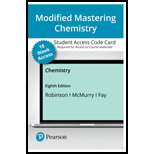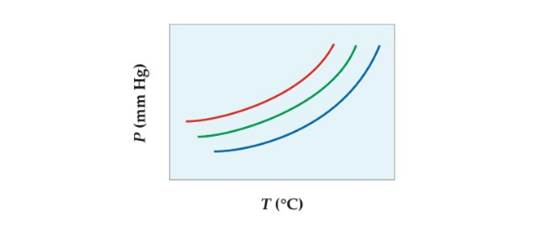
CHEMISTRY-MOD.MASTERING (18W)
8th Edition
ISBN: 9780136780922
Author: Robinson
Publisher: PEARSON
expand_more
expand_more
format_list_bulleted
Textbook Question
Chapter 13, Problem 13.16A
Conceptual APPLY 12.18 The following diagram shows a close-up view of part of the vapor-pressure curves for two pure liquids and a mixture of the two. Which curves represent pure liquids, and which represents the mixture?

Expert Solution & Answer
Want to see the full answer?
Check out a sample textbook solution
Students have asked these similar questions
please solve this, and help me know which boxes to check. Thank you so much in advance.
Electronegativity is a measure of the tendency of an atom to attract a bonding pair of electrons. Describe how electronegativity is illustrated on the periodic table including trends between groups and periods and significance of atom size.
Define the term “transition.” How does this definition apply to the transition metals?
Chapter 13 Solutions
CHEMISTRY-MOD.MASTERING (18W)
Ch. 13 - Prob. 13.1PCh. 13 - Prob. 13.2ACh. 13 - Prob. 13.3PCh. 13 - Prob. 13.4ACh. 13 - PRACTICE 12.5 A 50.0 mL sample of drinking water...Ch. 13 - APPLY 12.6 The legal limit for human exposure to...Ch. 13 - PRACTICE 12.7 What mass in grams of a 0.500 m...Ch. 13 - APPLY 12.8 What is the molality of a solution...Ch. 13 - PRACTICE 12.9 The density at 20°C of a 0.500 M...Ch. 13 - APPLY 12.10 The density at 20°C of a 0.258 m...
Ch. 13 - ThesolubilityofCO2inwateris 3.2102 M at 25 °C...Ch. 13 - APPLY 12.12 Use the Henry’s law constant you...Ch. 13 - PRACTICE 12.13 What is the vapor pressure in mm Hg...Ch. 13 - APPLY 12.14 A solution made by dissolving 8.110 g...Ch. 13 - PRACTICE 12.17 What is the vapor pressure of the...Ch. 13 - Conceptual APPLY 12.18 The following diagram shows...Ch. 13 - What is the normal boiling point in °C of an...Ch. 13 - APPLY 12.20 The following phase diagram shows a...Ch. 13 - Prob. 13.19PCh. 13 - APPLY 12.22 Cells in the human eye have an osmotic...Ch. 13 - PRACTICE 12.23 A solution prepared by dissolving...Ch. 13 - Prob. 13.22ACh. 13 - PROBLEM 12.25 What is the difference between a...Ch. 13 - PROBLEM 12.26 Urea has a high solubility in blood...Ch. 13 - Use Table 13.5 to calculate the osmotic pressure...Ch. 13 - Prob. 13.26PCh. 13 - Many people take vitamin supplements to promote...Ch. 13 - Prob. 13.28CPCh. 13 - Prob. 13.29CPCh. 13 - Prob. 13.30CPCh. 13 - Prob. 13.31CPCh. 13 - Prob. 13.32CPCh. 13 - Prob. 13.33CPCh. 13 - Prob. 13.34CPCh. 13 - Prob. 13.35CPCh. 13 - Prob. 13.36SPCh. 13 - 12.41 Why do ionic substances with higher lattice...Ch. 13 - Prob. 13.38SPCh. 13 - Prob. 13.39SPCh. 13 - Classify the strongest type of intermolecular...Ch. 13 - Classify the strongest type of intermolecular...Ch. 13 - Prob. 13.42SPCh. 13 - Prob. 13.43SPCh. 13 - Br2 is much more soluble in tetrachloromethane,...Ch. 13 - Predict whether the solubility of formaldehyde,...Ch. 13 - Prob. 13.46SPCh. 13 - Prob. 13.47SPCh. 13 - Arrange the following compounds in order of their...Ch. 13 - Prob. 13.49SPCh. 13 - Prob. 13.50SPCh. 13 - Prob. 13.51SPCh. 13 - Prob. 13.52SPCh. 13 - Prob. 13.53SPCh. 13 - The dissolution of CaCl2(s) in water is...Ch. 13 - The dissolution of NH4ClO4(s) in water is...Ch. 13 - Assuming that seawater is an aqueous solution of...Ch. 13 - Prob. 13.57SPCh. 13 - Propranolol°C16H21NO2) a so-called beta-blocker...Ch. 13 - Prob. 13.59SPCh. 13 - How would you prepare each of the following...Ch. 13 - Prob. 13.61SPCh. 13 - Prob. 13.62SPCh. 13 - Prob. 13.63SPCh. 13 - Prob. 13.64SPCh. 13 - Which of the following solutions has the higher...Ch. 13 - What is the mass percent concentration of the...Ch. 13 - Prob. 13.67SPCh. 13 - Prob. 13.68SPCh. 13 - Prob. 13.69SPCh. 13 - What is the concentration of each of the following...Ch. 13 - Prob. 13.71SPCh. 13 - The density of a 16.0 mass % solution of sulfuric...Ch. 13 - Prob. 13.73SPCh. 13 - What is the molality of the 40.0 mass % ethylene...Ch. 13 - Prob. 13.75SPCh. 13 - Prob. 13.76SPCh. 13 - Prob. 13.77SPCh. 13 - Prob. 13.78SPCh. 13 - Prob. 13.79SPCh. 13 - Look at the solubility graph in Figure 13.7, and...Ch. 13 - Prob. 13.81SPCh. 13 - Prob. 13.82SPCh. 13 - Prob. 13.83SPCh. 13 - Fish generally need an O2 concentration in water...Ch. 13 - At an altitude of 10, 000 ft, the partial pressure...Ch. 13 - Prob. 13.86SPCh. 13 - Prob. 13.87SPCh. 13 - Prob. 13.88SPCh. 13 - When solid CaCl2 is added to liquid water, the...Ch. 13 - Rank the following aqueous solutions from lowest...Ch. 13 - Which of the following aqueous solutions has the...Ch. 13 - What is the vapor pressure in mm Hg of a solution...Ch. 13 - What is the normal boiling point in oC of a...Ch. 13 - What is the freezing point in °C of a solution...Ch. 13 - Assuming complete dissociation, what is the...Ch. 13 - When 9.12 g of HCI was dissolved in 190 g of...Ch. 13 - Prob. 13.97SPCh. 13 - When 1 mol of NaCI is added to 1 L of water, the...Ch. 13 - Prob. 13.99SPCh. 13 - Draw a phase diagram showing how the phase...Ch. 13 - Prob. 13.101SPCh. 13 - What is the vapor pressure in mm Hg of the...Ch. 13 - What is the vapor pressure in mm Hg of a solution...Ch. 13 - What is the boiling point in oC of each of the...Ch. 13 - What is the freezing point in oC of each of the...Ch. 13 - Prob. 13.106SPCh. 13 - The van’t Hoff factor for KCl is i=1.85. What is...Ch. 13 - Hepatane (C7H16) and octane (C8H18) are...Ch. 13 - Prob. 13.109SPCh. 13 - Acetone, C3H6O , and ethyl acetate, C4H8O2, are...Ch. 13 - Prob. 13.111SPCh. 13 - Prob. 13.112SPCh. 13 - What is the mole fraction of each component in the...Ch. 13 - Prob. 13.114SPCh. 13 - A solution prepared by dissolving 3.00 g of...Ch. 13 - Prob. 13.116SPCh. 13 - Prob. 13.117SPCh. 13 - Prob. 13.118SPCh. 13 - What osmotic presure in mm Hg would you expect for...Ch. 13 - Prob. 13.120SPCh. 13 - Prob. 13.121SPCh. 13 - Prob. 13.122SPCh. 13 - If cost per gram were not a concern, which of the...Ch. 13 - Prob. 13.124SPCh. 13 - Met-enkephalin is one of the so-called endorphins,...Ch. 13 - Prob. 13.126SPCh. 13 - Prob. 13.127SPCh. 13 - Prob. 13.128SPCh. 13 - Prob. 13.129SPCh. 13 - How many grams of naphthalene, C10H8 (commonly...Ch. 13 - Prob. 13.131SPCh. 13 - Assuming that seawater is a 3.5 mass % solution of...Ch. 13 - There’s actually much more in seawater than just...Ch. 13 - Prob. 13.134SPCh. 13 - What is the van’t Hoff factor for K2SO4 in an...Ch. 13 - If the van’t Hoff factor for Lid in a 0.62 m...Ch. 13 - What is the value of the van’t Hoff factor for KCI...Ch. 13 - A solid mixture of KCI, KNO3, and Ba(N03)2 is...Ch. 13 - Prob. 13.139SPCh. 13 - An aqueous solution of a certain organic compound...Ch. 13 - Prob. 13.141SPCh. 13 - Prob. 13.142SPCh. 13 - A solution of 0.250 g of naphthalene (mothballs)...Ch. 13 - Prob. 13.144SPCh. 13 - Prob. 13.145SPCh. 13 - The steroid hormone estradiol contains only C, H,...Ch. 13 - Many acids are partially dissociated into ions in...Ch. 13 - Addition of 50.00 mL of 2.238 H2SO4 (solution...Ch. 13 - Prob. 13.149MPCh. 13 - Prob. 13.150MPCh. 13 - Combustion analysis of a 36.72-mg sample of the...Ch. 13 - Prob. 13.152MPCh. 13 - Prob. 13.153MPCh. 13 - Prob. 13.154MP
Knowledge Booster
Learn more about
Need a deep-dive on the concept behind this application? Look no further. Learn more about this topic, chemistry and related others by exploring similar questions and additional content below.Similar questions
- Describe how the properties of the different types of elements (metals, nonmetals, metalloids) differ.arrow_forwardUse a textbook or other valid source to research the physical and chemical properties of each element listed in Data Table 1 using the following as a guideline: Ductile (able to be deformed without losing toughness) and malleable (able to be hammered or pressed permanently out of shape without breaking or cracking) or not ductile or malleable Good, semi, or poor conductors of electricity and heat High or low melting and boiling points Occur or do not occur uncombined/freely in nature High, intermediate, or low reactivity Loses or gains electrons during reactions or is not reactivearrow_forwardProvide the Physical and Chemical Properties of Elements of the following elements listedarrow_forward
- Questions 4 and 5arrow_forwardFor a titration of 40.00 mL of 0.0500 M oxalic acid H2C2O4 with 0.1000 M KOH, calculate the pH at each of the following volume of KOH used in the titration: 1) before the titration begin;2) 15 mL; 3) 20 mL; 4) 25 mL; 5) 40 mL; 6) 50 mL. Ka1 = 5.90×10^-2, Ka2 = 6.50×10^-5 for oxalic acid.arrow_forwardPredict the major organic product(s), if any, of the following reactions. Assume all reagents are in excess unless otherwise indicated.arrow_forward
- Predict the major organic product(s), if any, of the following reactions. Assume all reagents are in excess unless otherwise indicated.arrow_forwardHow many signals would you expect to find in the 1 H NMR spectrum of each given compound? Part 1 of 2 2 Part 2 of 2 HO 5 ☑ Х IIIIII***** §arrow_forwardA carbonyl compound has a molecular ion with a m/z of 86. The mass spectra of this compound also has a base peak with a m/z of 57. Draw the correct structure of this molecule. Drawingarrow_forward
- Can you draw this using Lewis dot structures and full structures in the same way they are so that I can better visualize them and then determine resonance?arrow_forwardSynthesize the following compound from cyclohexanol, ethanol, and any other needed reagentsarrow_forwardFor a titration of 20.00 mL of 0.0500 M H2SO4 with 0.100 M KOH, calculate the pH at each of the following volume of KOH used in the titration: 1) before the titration begin; 2) 10.00 mL; 3) 20.00 mL; 4) 30.00 mL. Ka2 = 1.20×10-2 for H2SO4.arrow_forward
arrow_back_ios
SEE MORE QUESTIONS
arrow_forward_ios
Recommended textbooks for you
 Introductory Chemistry: A FoundationChemistryISBN:9781337399425Author:Steven S. Zumdahl, Donald J. DeCostePublisher:Cengage Learning
Introductory Chemistry: A FoundationChemistryISBN:9781337399425Author:Steven S. Zumdahl, Donald J. DeCostePublisher:Cengage Learning ChemistryChemistryISBN:9781305957404Author:Steven S. Zumdahl, Susan A. Zumdahl, Donald J. DeCostePublisher:Cengage Learning
ChemistryChemistryISBN:9781305957404Author:Steven S. Zumdahl, Susan A. Zumdahl, Donald J. DeCostePublisher:Cengage Learning Chemistry: An Atoms First ApproachChemistryISBN:9781305079243Author:Steven S. Zumdahl, Susan A. ZumdahlPublisher:Cengage Learning
Chemistry: An Atoms First ApproachChemistryISBN:9781305079243Author:Steven S. Zumdahl, Susan A. ZumdahlPublisher:Cengage Learning
 Chemistry: Principles and PracticeChemistryISBN:9780534420123Author:Daniel L. Reger, Scott R. Goode, David W. Ball, Edward MercerPublisher:Cengage Learning
Chemistry: Principles and PracticeChemistryISBN:9780534420123Author:Daniel L. Reger, Scott R. Goode, David W. Ball, Edward MercerPublisher:Cengage Learning General Chemistry - Standalone book (MindTap Cour...ChemistryISBN:9781305580343Author:Steven D. Gammon, Ebbing, Darrell Ebbing, Steven D., Darrell; Gammon, Darrell Ebbing; Steven D. Gammon, Darrell D.; Gammon, Ebbing; Steven D. Gammon; DarrellPublisher:Cengage Learning
General Chemistry - Standalone book (MindTap Cour...ChemistryISBN:9781305580343Author:Steven D. Gammon, Ebbing, Darrell Ebbing, Steven D., Darrell; Gammon, Darrell Ebbing; Steven D. Gammon, Darrell D.; Gammon, Ebbing; Steven D. Gammon; DarrellPublisher:Cengage Learning

Introductory Chemistry: A Foundation
Chemistry
ISBN:9781337399425
Author:Steven S. Zumdahl, Donald J. DeCoste
Publisher:Cengage Learning

Chemistry
Chemistry
ISBN:9781305957404
Author:Steven S. Zumdahl, Susan A. Zumdahl, Donald J. DeCoste
Publisher:Cengage Learning

Chemistry: An Atoms First Approach
Chemistry
ISBN:9781305079243
Author:Steven S. Zumdahl, Susan A. Zumdahl
Publisher:Cengage Learning


Chemistry: Principles and Practice
Chemistry
ISBN:9780534420123
Author:Daniel L. Reger, Scott R. Goode, David W. Ball, Edward Mercer
Publisher:Cengage Learning

General Chemistry - Standalone book (MindTap Cour...
Chemistry
ISBN:9781305580343
Author:Steven D. Gammon, Ebbing, Darrell Ebbing, Steven D., Darrell; Gammon, Darrell Ebbing; Steven D. Gammon, Darrell D.; Gammon, Ebbing; Steven D. Gammon; Darrell
Publisher:Cengage Learning
Intermolecular Forces and Boiling Points; Author: Professor Dave Explains;https://www.youtube.com/watch?v=08kGgrqaZXA;License: Standard YouTube License, CC-BY